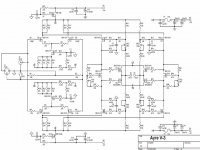IF global NFB is bad then local NFB or EC is bad as well. Full stop. Period. Basta. Finito.
I don't understand this claim.Absolutely!
Mean you this in respect to unwanted oscillations or in respect to the reachable sonic performance?
Thank you very much to the advice of Charles Hansen's audio design philosophy. Are there also basic schematics of amplifiers, where are Charles Hansen's design's inside?I have a great deal of respect for Charles Hansen's audio design philosophy for Ayre products.
1) Amplifiers with only local feedback sound different than amplifiers with global feedback. Charles believes they sound more musical.
--Especially if JFETS are used for the input stage and voltage gain stage.
2) High output dampening on a non-global-feedback amplifier is desirable.
--Can be achievied with a large number of output transistors.
--Charles prefers using more parallel outputs over the Hawksford type EC.
3) If you are going to use global feedback, it is best to use a lot of feedback.
---Global feedback generates higher harmonics, especially odd harmonics, and high global feedback is required to substantially push their absolute value down.
Charles Hansen from Stereophile interview:
"I have some beliefs that approach religious faith: FETs are better than bipolars, zero feedback is better than feedback, balanced is better than single-ended, and the simpler a circuit, the better. But here's the thing: Just because I believe something doesn't make it true, and designing the MX-R taught me some lessons.
"The first is that, in parts of the circuit, bipolar devices sound better than FETs, so that's what we used. (the Arye MX-R uses 16 ThermaTrak bipolar output transistors). And then there's the EquiLock circuit, which violates my 'simpler is better' dictum. EquiLock is kind of like creating a cascode by combining two triodes. You could say we're joining together two transistors to act like one transistor that has a really stable operating point. Adding a second transistor to the signal path seems like it deviates from my belief that simpler is better, except that it works better."
Key to Ayre's development is what they call EquiLock circuitry for the MX-R monoblock. "In a conventional circuit, the gain transistor has a load, usually either a resistor or a current source," Hansen said. "When the current through the gain transistor changes, then the voltage across the load also changes, which, in turn, means that the voltage across the gain transistor is changing. In fact, all of the parameters (transconductance, capacitance, etc.) vary when the voltage across the transistor varies.
"The EquiLock circuit adds another transistor between the gain transistor and the load. (In our case, the load is actually a current mirror.) This extra transistor holds the voltage of the gain transistor at a fixed level while still transmitting the changes in current to the load (the current mirror). By stabilizing the voltage across the gain transistor, all of the parameters of the gain transistor are also stabilized. The circuit is very similar to a cascode circuit, which has been used by other manufacturers, but EquiLock is an improvement over a conventional cascode circuit."
At first look such a comparable listening test is easy. One go on and replace the NFB resistor from output to inverted input through an attenuator/potentiometer. However in real life there is a great risk of unwanted oscillations. Thus for each global feedback alignment Cdom and some other caps must have an other value set.Edmond I completely agree with you. Just I never had a chance to compare high GNFG to the low GNFG amps. All my amps were high GNFG type. Here I sow possibility to use the same PCB layout and try both types with very similar circuit configuration. You can't deny that some people think low GNFG sounds better. Did you ever had a chance to compare?
Damir
BTW - what means the term "GNFG" ?? Mean you GNFB (global negative feedback) ??
Last edited:
BTW - what means the term "GNFG" ?? Mean you GNFB (global negative feedback) ??
Of course, that was typing failure.
Are there also basic schematics of amplifiers, where are Charles Hansen's design's inside? QUOTE]
This schematic of the much earlier Ayre V3 all MOS amp has been posted in a few circuits forums.
The topology appears closer to Charles' core religious faith: "FETs are better than bipolars, zero feedback is better than feedback, balanced is better than single-ended, and the simpler a circuit, the better. "
Attachments
The EquiLock circuit adds another transistor between the gain transistor and the load.
"Equilock" is marketing speak for cascodeing, big deal.
"Equilock" is marketing speak for cascodeing, big deal.
I think there is much more to that, read the discription given by him carefully, its a better way of cascoding, I dont think you have seen these cascodes used before in audio.
the description hinges on their definition of "conventional cascode" - and would be completely consistent with "equilock" being the cascode that references the Vbias to the control device emitter/source - returning the cascode device base/gate current to the control device emitter/source
while calling gnd referenced Vbias for the cascode device “conventional cascode”
the most accessible explanation is Hawksford but he doesn't come close to having priority
http://www.essex.ac.uk/csee/research/audio_lab/malcolmspubdocs/J10 Enhanced cascode.pdf
Pass has used “the correct” version of the cascode as well
while calling gnd referenced Vbias for the cascode device “conventional cascode”
the most accessible explanation is Hawksford but he doesn't come close to having priority
http://www.essex.ac.uk/csee/research/audio_lab/malcolmspubdocs/J10 Enhanced cascode.pdf
Pass has used “the correct” version of the cascode as well
Are there also basic schematics of amplifiers, where are Charles Hansen's design's inside? QUOTE]
This schematic of the much earlier Ayre V3 all MOS amp has been posted in a few circuits forums.
The topology appears closer to Charles' core religious faith: "FETs are better than bipolars, zero feedback is better than feedback, balanced is better than single-ended, and the simpler a circuit, the better. "
Thank you for this informations.
At first look I don't find the resistors which determine the present voltage gain factor.
various pics from Charles Hansen's AYRE V3 from
°ÑAYRE V3ÍѹâÉíÌå¼ñ²é - ÒôÏìDIYÂÛ̳ - HIFIDIYÂÛ̳ - Powered by Discuz!
in the attachement
various threads - Charles Hansen
http://www.diyaudio.com/forums/solid-state/35480-charles-hansen-come-please.html
http://www.diyaudio.com/forums/solid-state/114314-please-mr-charles-hansen-konrad-help.html
http://www.diyaudio.com/forums/solid-state/34599-hp339a-article-charles-hansen.html
http://www.diyaudio.com/forums/solid-state/29464-another-zero-feedback-amplifier.html
http://www.diyaudio.com/forums/solid-state/28764-feedback-artifacts-cars-semantics.html
http://www.diyaudio.com/forums/solid-state/68197-new-naim-output-transistors.html
http://www.diyaudio.com/forums/chip-amps/73497-sound-quality-snubbers.html
http://www.diyaudio.com/forums/analog-line-level/197686-pps-caps.html
more threads started by Charles Hansen:
diyAudio
Attachments
-
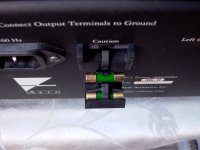 Ayre V3 rear fuse-aera.jpg90.4 KB · Views: 214
Ayre V3 rear fuse-aera.jpg90.4 KB · Views: 214 -
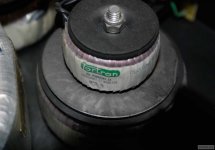 AYRE V3 inside-torodials.jpg111.1 KB · Views: 202
AYRE V3 inside-torodials.jpg111.1 KB · Views: 202 -
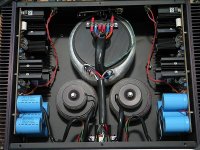 AYRE V3 inside-II.jpg60.3 KB · Views: 231
AYRE V3 inside-II.jpg60.3 KB · Views: 231 -
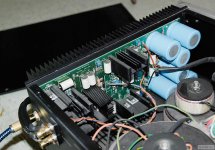 AYRE V3 inside-I.jpg239.2 KB · Views: 284
AYRE V3 inside-I.jpg239.2 KB · Views: 284 -
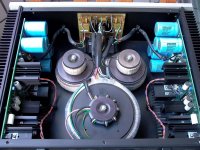 Ayre V3 inside front-aera.jpg196.4 KB · Views: 248
Ayre V3 inside front-aera.jpg196.4 KB · Views: 248 -
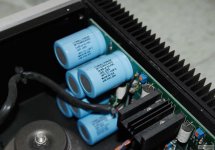 AYRE V3 inside- Cornell Dubilier PS Caps.jpg146.1 KB · Views: 655
AYRE V3 inside- Cornell Dubilier PS Caps.jpg146.1 KB · Views: 655 -
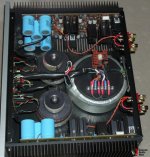 AYRE V3 inside - top view.jpg191.1 KB · Views: 696
AYRE V3 inside - top view.jpg191.1 KB · Views: 696 -
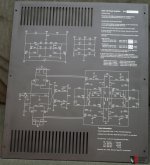 AYRE V3 cover incl. schema .jpg170.1 KB · Views: 772
AYRE V3 cover incl. schema .jpg170.1 KB · Views: 772 -
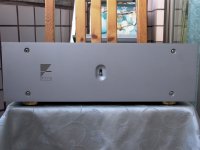 Ayre V3 front-silver.jpg99.6 KB · Views: 785
Ayre V3 front-silver.jpg99.6 KB · Views: 785 -
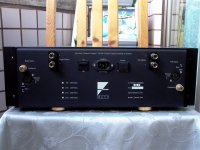 Ayre V3 rear.jpg130.4 KB · Views: 243
Ayre V3 rear.jpg130.4 KB · Views: 243
Last edited:
...At first look I don't find the resistors which determine the present voltage gain factor.
from the cover plate silkscreen pic a guess is:
diff pair degeneration R, together with input fet gm determine a input stage gm
folded cascode loaded with R to gnd determines amp V gain: gm*R
I don't understand this claim.
Mean you this in respect to unwanted oscillations or in respect to the reachable sonic performance?
..............
And I don't understand why local feedback is acceptable and global feedback is not. As a matter of fact, I don't claim anything, rather those ..... from anti GNFB brigade 'claim' utter nonsense.
Edmond,
If you build both, keeping them otherwise as similar as possible, you do find differences in the sound. I don't know either, but it's definitely there. And if Charles Hansen, a smart guy from all reports, feels there is a difference, it probably bears investigation.
I have built very similar circuits, one with interstage, and one with global fb, and noticed palpable differences. I even have one amp with an output stage running open loop, and it is superb. I can't explain it either.
Hugh
If you build both, keeping them otherwise as similar as possible, you do find differences in the sound. I don't know either, but it's definitely there. And if Charles Hansen, a smart guy from all reports, feels there is a difference, it probably bears investigation.
I have built very similar circuits, one with interstage, and one with global fb, and noticed palpable differences. I even have one amp with an output stage running open loop, and it is superb. I can't explain it either.
Hugh
I can't explain it either.
Hi Hugh,
My sister, she is a musician !!!, claims that her stone aged stereo set (that rolls off at 10kHz + lots of x-over distortion) sounds much better than any high end toy. So............
Cheers, Edmond.
Hi Hugh,
My sister, she is a musician !!!, claims that her stone aged stereo set (that rolls off at 10kHz + lots of x-over distortion) sounds much better than any high end toy. So............
Cheers, Edmond.
Yes, it's frustrating, but musicians are a special kind of listener; they ignore the technology and fill in the gaps subliminally, perhaps not a good example!
However, I have found that since H2/H3/H4 are all musical, the only distortions that really seem to matter are H5 and beyond. With global feedback, I have noticed the train of artefacts is extended, even though THD is lower.
Hugh
However, I have found that since H2/H3/H4 are all musical, the only distortions that really seem to matter are H5 and beyond. With global feedback, I have noticed the train of artefacts is extended, even though THD is lower.
Hugh
read this thread carefully:And I don't understand why local feedback is acceptable and global feedback is not. As a matter of fact, I don't claim anything, rather those ..... from anti GNFB brigade 'claim' utter nonsense.
http://www.diyaudio.com/forums/soli...-nfb-negative-feedback-me-wrong-question.html
Because the most user's don't work with a bi-amping or multiamping/active mode it is actually neseccary, to select various feedback loops:
1) Global negative feedback (both inverted and non inverted mode) - the most used mode
2) NFB without the output buffer stage in the feedback lope (as realized by the STASIS topology e. g.)
3) as before, but with only single gain stage instead two gain stages in the NFB loop (to realize through emitter/source resistors for LTP with unity gain or lower - or with folded cascode and without additional VAS at the same time)
4) only local serial feedback (introduce of emitter resistors both in the LTP and in the VAS stage)
Unfortunately until this day I don't know commercial amp devices, where this is possible.
Who are the right developers therefore ?
This methody helps to optimize various sonic character of the wide range of loudspeakers to obtain the satisfaction of personal acoustical taste.
Last edited:
Hi tiefbassuebertr
Of course, certain circuit details do have an impact on the 'sonic character' (a bad thing, btw). But that's not what I am talking about.
Instead, I'm talking about whether NFB is good or bad. If it's good when only a few active components are enclosed inside the FB loop, then it makes no sense it should be bad when a few more active components are enclosed (that is, of course, under the premise that the rules for a stable FB loop are strictly obeyed).
Of course, certain circuit details do have an impact on the 'sonic character' (a bad thing, btw). But that's not what I am talking about.
Instead, I'm talking about whether NFB is good or bad. If it's good when only a few active components are enclosed inside the FB loop, then it makes no sense it should be bad when a few more active components are enclosed (that is, of course, under the premise that the rules for a stable FB loop are strictly obeyed).
Then there are these excellent amps !
Lavardin Technologies - Model IT
Heeps of Global feedback and winner of many awards.
Compaired one to a low feedback high power Electrocompaniet I own, there are some differences but I cant say that I would prefer the low feedback one, they both have their virtues.
Lavardin Technologies - Model IT
Heeps of Global feedback and winner of many awards.
Compaired one to a low feedback high power Electrocompaniet I own, there are some differences but I cant say that I would prefer the low feedback one, they both have their virtues.
Here the associated thread:
http://www.diyaudio.com/forums/solid-state/114865-densen-amp.html
This circuit topology is very good suited to implement a selector for various feedback kinds according post #34
AboutThen there are these excellent amps !
Lavardin Technologies - Model IT
Heeps of Global feedback and winner of many awards.
Compaired one to a low feedback high power Electrocompaniet I own, there are some differences but I cant say that I would prefer the low feedback one, they both have their virtues.
http://www.diyaudio.com/forums/pass...adin-no-memory-distortion-ultimate-aleph.html
you will find various details concerning the topology (Memory Distortion)
Last edited:
I think in general we should remember that Negative Feedback is there to solve a problem. Whether or not it's the best answer to that problem probably lies in it's implementation and the effect, if any, it has as far as introducing another problem while attempting to solve the first.
Sometimes we get a cure, sometimes we get a treatment without a cure that reduces the problem, and sometimes the cure is worse than the disease. I think there are probably examples of all three when we look at various amplification products and NFB implementations found within them.
We probably all know of situations where "if some is good, then too much ought to be just right" creates excellent examples of what not to do.
Also, I think we should be careful to revisit the original problem from time to time, rather than just add NFB "because that's the way we've always done it". The "state of the art" (and I mean it in the classic sense, as in what we know know now versus what we knew then, not in the sense of a marketing slogan) changes inevitably over time.
We should be sure we're not trying to fix a problem that has gone away as we advance our knowledge of how to build an amplifier circuit and what components are readily available to build them with. Of course, to do that, we need to see if we can build stuff with and without NFB from time to time, so clearly there's a place for both approaches.
Sometimes we get a cure, sometimes we get a treatment without a cure that reduces the problem, and sometimes the cure is worse than the disease. I think there are probably examples of all three when we look at various amplification products and NFB implementations found within them.
We probably all know of situations where "if some is good, then too much ought to be just right" creates excellent examples of what not to do.
Also, I think we should be careful to revisit the original problem from time to time, rather than just add NFB "because that's the way we've always done it". The "state of the art" (and I mean it in the classic sense, as in what we know know now versus what we knew then, not in the sense of a marketing slogan) changes inevitably over time.
We should be sure we're not trying to fix a problem that has gone away as we advance our knowledge of how to build an amplifier circuit and what components are readily available to build them with. Of course, to do that, we need to see if we can build stuff with and without NFB from time to time, so clearly there's a place for both approaches.
This reasoning is somewhat too general to me, because the audible effects of both are in the lower and upper frequency range perceived very differently. But the measuring effect is still the same in direction to very high frequencies far outside the audible spectrum: either reduction of the sine wave magnitude (maximum one voltage gain stages within the loop) or degeneration of the sine wave to a triangular signal (triangle/sawtooth wave) if two gain stage inside the NFB loop - go to attachement from post #9 aboutHi tiefbassuebertr
Of course, certain circuit details do have an impact on the 'sonic character' (a bad thing, btw). But that's not what I am talking about.
Instead, I'm talking about whether NFB is good or bad. If it's good when only a few active components are enclosed inside the FB loop, then it makes no sense it should be bad when a few more active components are enclosed (that is, of course, under the premise that the rules for a stable FB loop are strictly obeyed).
http://www.diyaudio.com/forums/pass...zero-o-os-0s-versus-later-aleph-versions.html
(last two diagrams).
One provides better results in the low frequency aera and the other in the upper frequency range (from the view of audible perception).
A lot of developers have still not understand this relationship.
Thus there are to find still both topologies by commercial power amp products.
Last edited:
- Status
- Not open for further replies.
- Home
- Amplifiers
- Solid State
- Zero negative feedback
